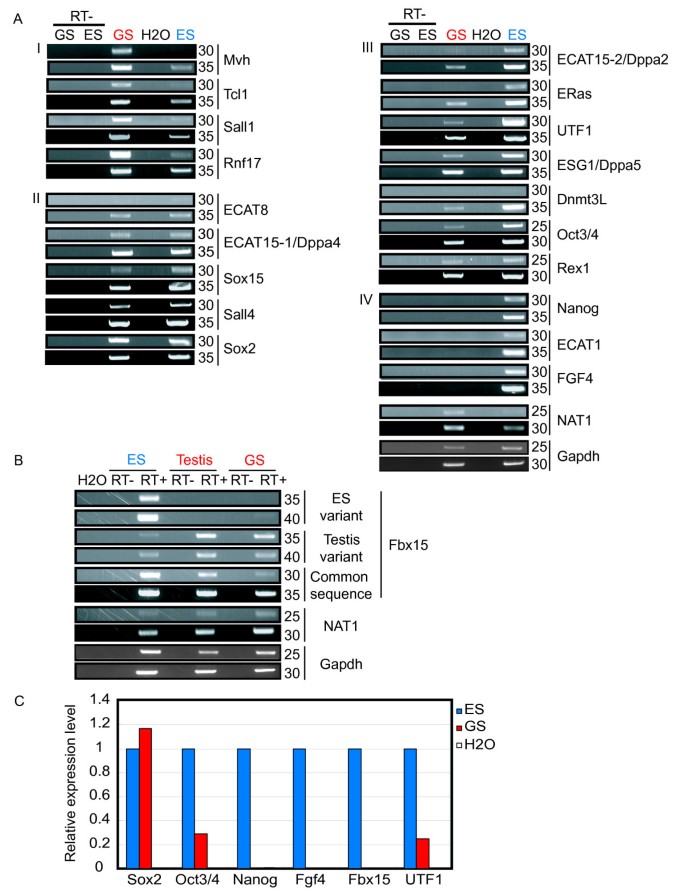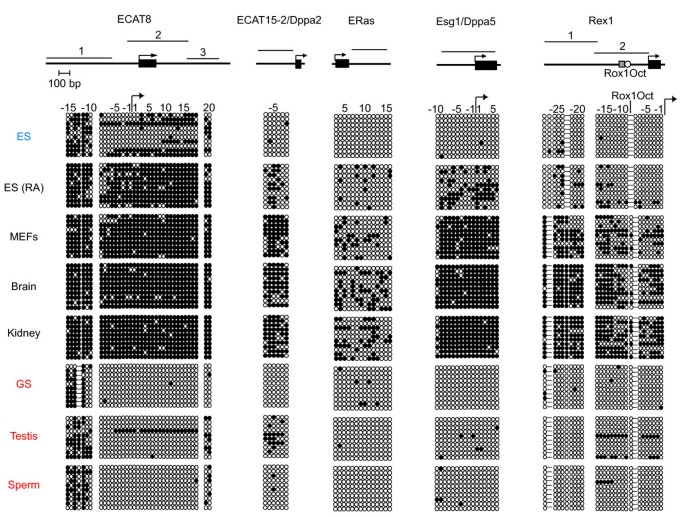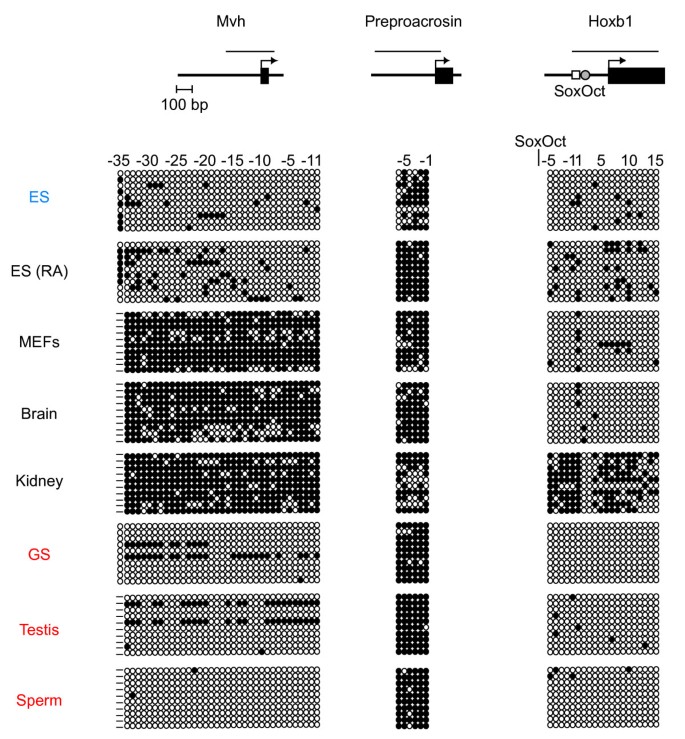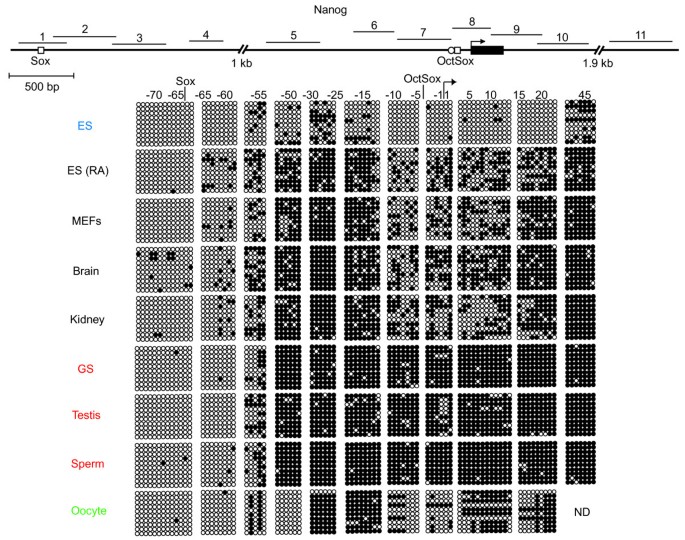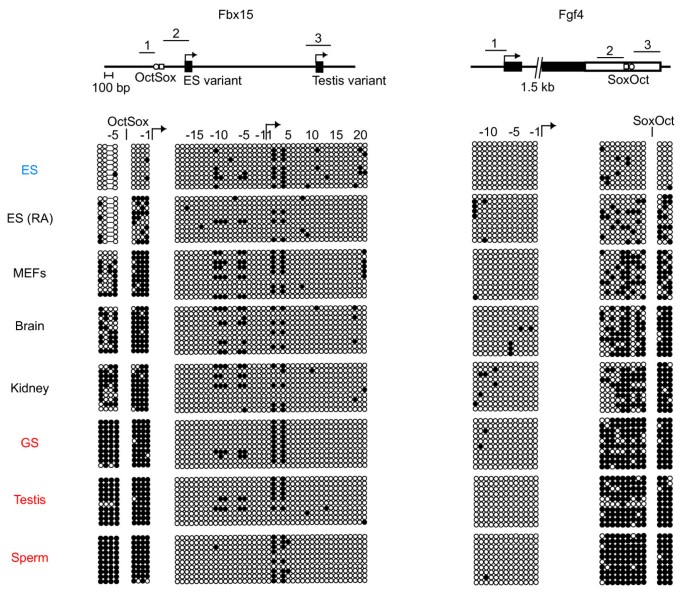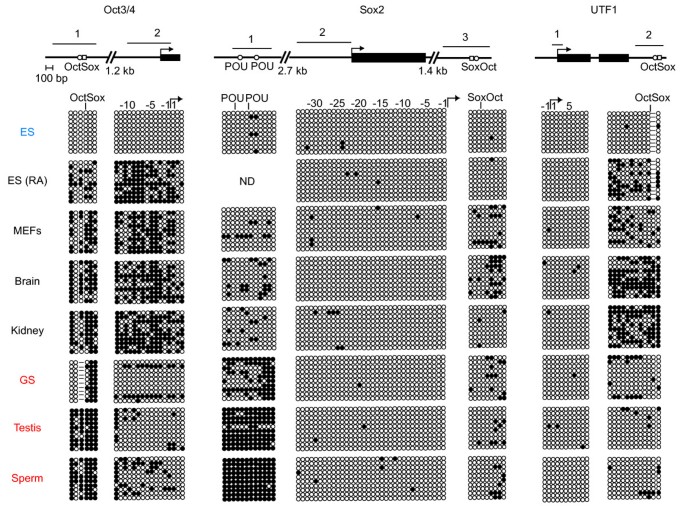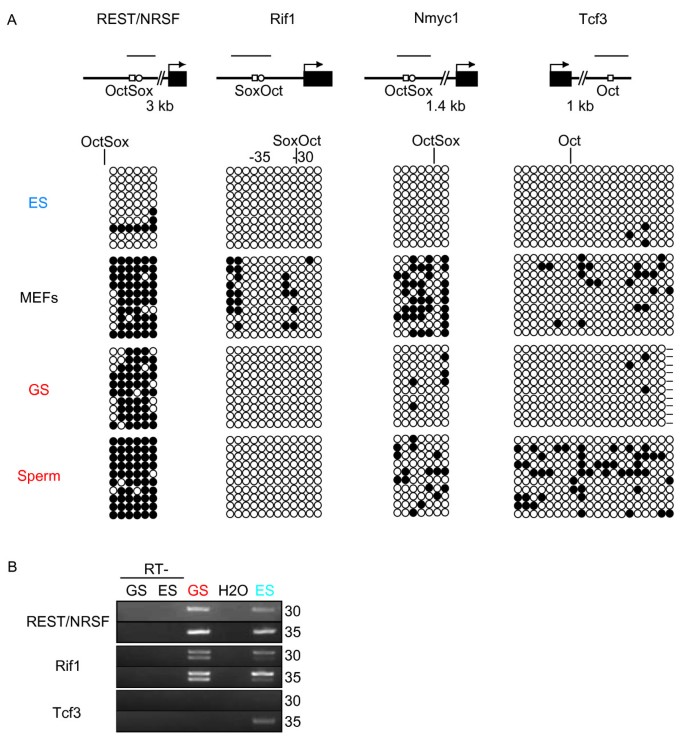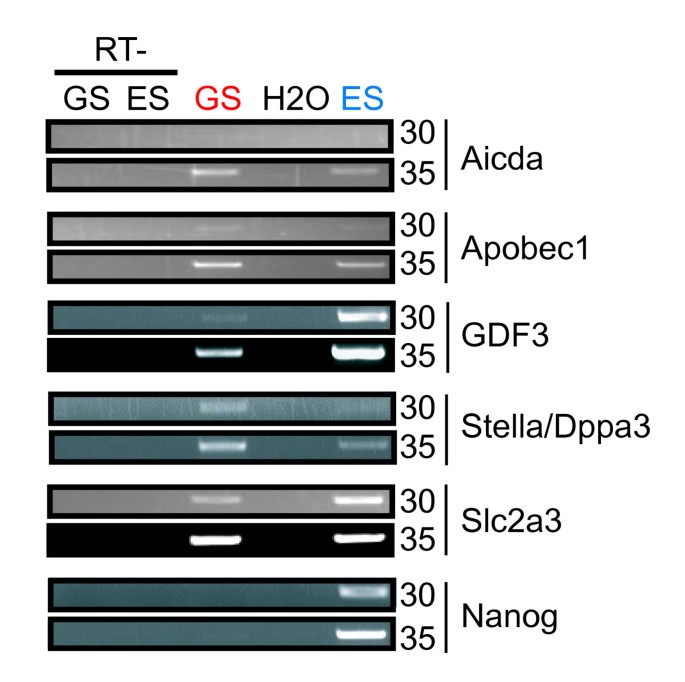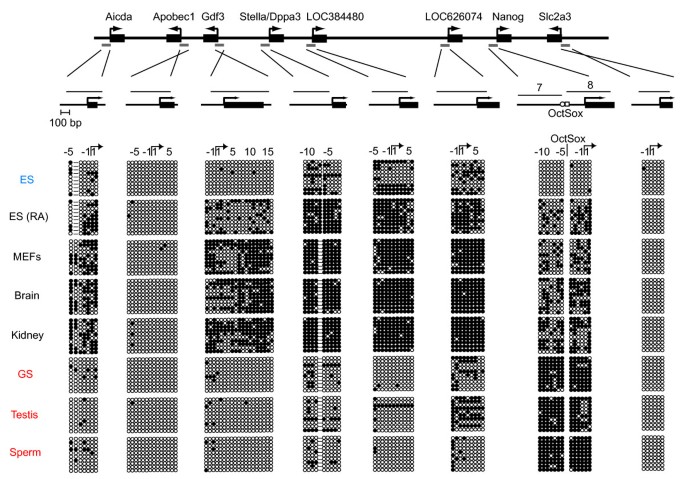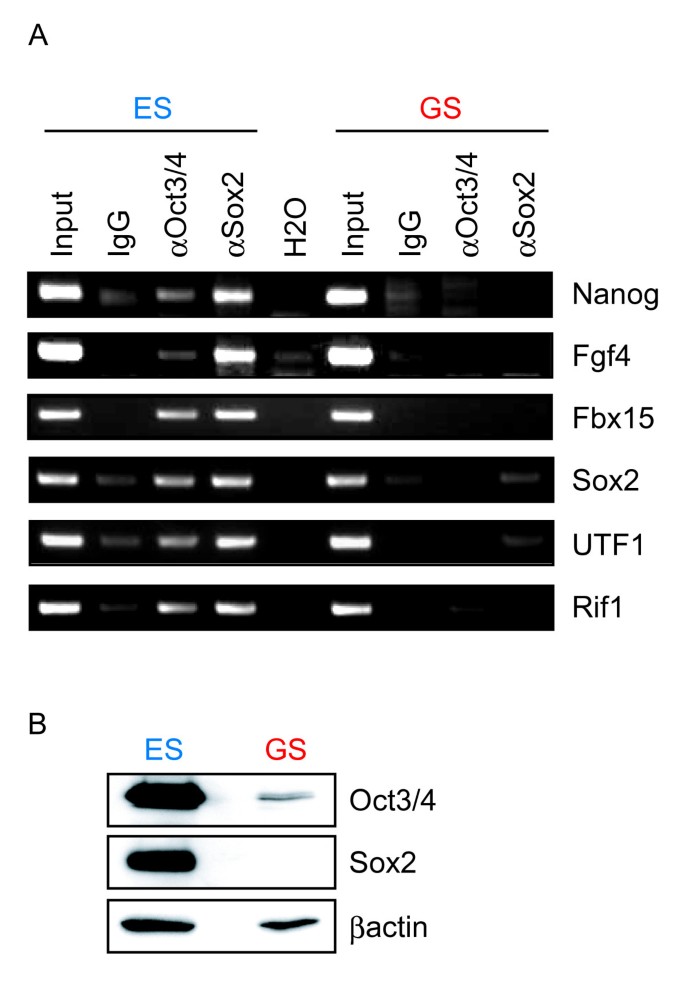Transcriptional repression and DNA hypermethylation of a small set of ES cell marker genes in male germline stem cells (original) (raw)
- Research article
- Open access
- Published: 21 July 2006
- Kyoko Miura1,
- Kumiko Iwabuchi1,
- Tomoko Ichisaka1,
- Masato Nakagawa1,
- Jiyoung Lee2,
- Mito Kanatsu-Shinohara2,3,
- Takashi Shinohara2 &
- …
- Shinya Yamanaka1,4
BMC Developmental Biology volume 6, Article number: 34 (2006)Cite this article
- 13k Accesses
- 113 Citations
- 9 Altmetric
- Metrics details
Abstract
Background
We previously identified a set of genes called ECATs (ES cell-associated transcripts) that are expressed at high levels in mouse ES cells. Here, we examine the expression and DNA methylation of ECATs in somatic cells and germ cells.
Results
In all ECATs examined, the promoter region had low methylation levels in ES cells, but higher levels in somatic cells. In contrast, in spite of their lack of pluripotency, male germline stem (GS) cells expressed most ECATs and exhibited hypomethylation of ECAT promoter regions. We observed a similar hypomethylation of ECAT loci in adult testis and isolated sperm. Some ECATs were even less methylated in male germ cells than in ES cells. However, a few ECATs were not expressed in GS cells, and most of them targets of Oct3/4 and Sox2. The Octamer/Sox regulatory elements were hypermethylated in these genes. In addition, we found that GS cells express little Sox2 protein and low Oct3/4 protein despite abundant expression of their transcripts.
Conclusion
Our results suggest that DNA hypermethylation and transcriptional repression of a small set of ECATs, together with post-transcriptional repression of Oct3/4 and Sox2, contribute to the loss of pluripotency in male germ cells.
Background
Embryonic stem (ES) cells possess many unique properties, including long-term self-renewal and pluripotency, which is the ability to differentiate into all types of somatic and germ cells[1, 2]. Previous studies showed that pluriopotency in ES cells and early embryos depend on genes that are specifically expressed in pluripotent cells. These genes, collectively dubbed "ECATs" for ES cell associated transcripts, include transcription factors such as Oct3/4 and Sox2. Oct3/4 maintains ES cells in an undifferentiated state in a dose-dependent manner[3, 4], and Sox2 functions synergistically with Oct3/4 in this process[5].
In addition to Oct3/4 and Sox2, we have identified a number of novel ECATs using digital differential display of expressed sequence tag (EST) databases. We found that Nanog/ecat4 is a homeodomain protein essential for self-renewal and pluripotency in ES cells and early embryos. Overexpression of Nanog allows for sustained self-renewal of ES cells even in the absence of leukemia inhibitory factor (LIF)[6, 7]. Another ECAT member, ERas/ecat5, is a constitutively active Ras-like protein that promotes the robust proliferation of ES cells[8].
Two possible mechanisms could account for the ES cell-specific expression of ECATs. One is the ES cell-specific expression of transcription factors that regulate expression of downstream ECATs. An example of this sort of _trans_-acting regulation is the activation of ES cell-specific genes such as _Fgf4_[9], _Rex1_[10], _Utf1_[11], _Fbx15_[12], and Nanog [13–15] by Oct3/4 and Sox2, which can also activate their own expression [16–18]. Alternatively, ES cell-specific expression could be achieved by epigenetic modifications, such as DNA methylation. For example, the _cis_-acting promoter and proximal/distal enhancer regions of Oct3/4 are hypomethylated in ES cells, whereas they are heavily methylated in somatic cells and in trophectoderm lineages[19]. Deletion of Dnmt3a and Dnmt3b, which are de novo DNA methyltransferases, results in global hypomethylation of genomic DNA and partial resistance to differentiation in mouse ES cells[20]. A similar phenomenon was also observed when ES cells were deprived of _CpG binding protein_[21]. These findings indicate that DNA methylation plays a pivotal role in gene regulation during differentiation and development.
Germ cells are themselves neither pluripotent nor totipotent, but are able to transmit totipotency to the next generation. The rapid recovery of totipotency by germ cells upon fertilization stands in stark contrast to the inability of somatic cells to recover totipotency or pluripotency once they have differentiated. Since ECATs play important roles in totipotency and pluripotency, it is possible that they are differentially regulated in somatic cells and germ cells. To test this idea, we examined the expression and DNA methylation of ECATs in somatic cells and germ cells. We found that many ECATs, including Oct3/4 and Sox2, were expressed in male germline stem (GS) cells, which are cultured spermatogonial stem cells derived from newborn mouse testes[22], despite their highly restricted potential. Furthermore, the regulatory regions of these genes were hypomethylated in GS cells and mature sperm. However, some ECAT genes, including Nanog, ECAT1, Fbx15, and Fgf4, were not expressed in GS cells. Among these, Nanog, Fbx15, and Fgf4 have been shown to be direct targets of synergistic activation by Oct3/4 and Sox2. The Octamer motif and Sox-binding sites of these three genes were hypermethylated in GS cells. Unexpectedly, we found that GS cells showed low Oct3/4 and little Sox2 protein levels despite high expression levels of the corresponding mRNA. We argue that the repression and DNA hypermethylation of a small set of ECATs, and the post-transcriptional suppression of Oct3/4 and Sox2 contribute to the loss of pluripotency in male germ cells and the rapid recovery of totipotency following fertilization.
Results
Most ECATs are expressed in male germline stem cells
To examine the expression of ECAT genes in germ cells, we performed RT-PCR analysis (Fig. 1). Expression of the germline marker mouse vasa homolog (Mvh)[23] confirmed GS cell identity. Most ECAT genes were expressed in GS cells but at different levels than in ES cells. Stella/dppa3 (Fig. 8), Tcl1, Sall1, and Rnf17 were expressed at higher levels in GS cells than in ES cells (group I), while GS cells and ES cells expressed similar levels of ECAT8, ECAT15-1/Dppa4, Sox15, Sall4, and Sox2 (group II). ECAT15-2/Dppa2, ERas, Gdf3 (Fig. 8), Utf1, Esg1/Dppa5, Dnmt3L, Oct3/4, and Rex1 expression was detected in GS cells, but at lower levels than in ES cells (group III).
Figure 1
Expression of ECATs in male germline stem (GS)cells and ES cells. A. RT-PCR was performed for the number of cycles shown on the right. We categorized ECATs into four groups based on their relative expression levels in GS cells compared to ES cells. To monitor amplification from genomic DNA, we amplified samples in which reverse transcriptase was omitted from the reverse transcription reaction (RT-). As negative controls, water was added instead of cDNA (H2O). NAT1 and Gapdh were used as loading controls. B. Expression of Fbx15 variants examined by RT-PCR. Our previous study using 5' RACE showed that Fbx15 is transcribed from different promoters in ES cells and testes in the mouse (unpublished data). The ES cell-specific variant was not detected in GS cells or adult testis, while the testis-specific variant was weakly detected in ES cells. The two transcripts differ only in exon 1 sequence. The common sequence of the two transcripts was also amplified. NAT1 and Gapdh were used as loading controls.C. Real-time PCR quantification of the expression of Oct3/4 and Sox2 target genes. The expression of each gene was normalized with that of Gapdh. The expression in ES cells was set as 1.0.
Repression of a small set of ECATs in GS cells
Although most ECATs were expressed in GS cells, we could not detect expression of ECAT1, Fgf4, or Nanog (group IV). In addition, we discovered that the ES cell-specific variant of Fbx15 was expressed in ES cells, but not in GS cells or testis. In contrast, the testis-specific variant of _Fbx1_5, which is transcribed from a different promoter, is expressed at high levels in GS cells and testis and but only weakly in ES cells (Fig. 1B). Quantification of transcript levels by real-time PCR confirmed that expression of Nanog, Fgf4, and Fbx15 was lost in GS cells (Fig. 1C).
DNA hypomethylation of ECATs that are expressed in GS cells
The expression of ECAT genes in GS cells suggested that they might show similar DNA methylation patterns in ES cells. To test this possibility, we performed bisulfite genomic sequencing of the regulatory regions of ECAT8, ECAT15-2/Dppa2, ERas, Esg1/Dppa5, and Rex1 (Fig. 2), all of which were expressed in both ES cells and GS cells. In ES cells, ECAT15-2/Dppa2, ERas, Esg1/Dppa5, and Rex1 showed hypomethylation, whereas ECAT8 showed partial methylation. In GS cells, ECAT15-2/Dppa2, ERas, Esg1/Dppa5, and Rex1 showed similar hypomethylation to that observed in ES cells. ECAT8 had lower methylation in GS cells than in ES cells. Similar methylation states were observed in testis and sperm from adult mice. We also observed hypomethylation of the promoters of Gdf3 and Stella/Dppa3 in GS cells (Fig. 9).
Figure 2
DNA methylation states of ECATs expressed in GS cells. Bisulfite genomic sequencing was performed to examine the DNA methylation profiles for the individual CpG sites of ECAT genes in ES cells, somatic cells, and male germ cells. Schematic diagrams of regions analyzed are shown in the upper part of the figure. Black rectangles represent the exons, and arrows indicate transcription initiation sites. Black horizontal bars indicate the regions analyzed. All of diagrams are in scale relative to a 100-bp scale bar. In the diagram for the Rex1 gene, the shaded square and open circle indicate the binding sites for Rox1 and Oct3/4, respectively. DNA methylation states in ES cells, somatic cells, and germ cells are shown in the lower part of the figure. Open circles indicate unmethylated CpGs and closed circles indicate methylated CpGs. The numbers indicate the relative positions of CpG sites from the transcription initiation site. The CpG nearest to the transcription initiation site is described as -1 (upstream) or 1 (downstream). Positions where CpG is absent due to DNA polymorphism are indicated by hyphens. ES, undifferentiated ES cells (129 background); ES (RA), ES cells differentiated by retinoic acid treatment; MEFs, MEFs derived from E13.5 C57BL/6J embryos; GS, GS cells derived from DBA neonate testis. Brain, kidney, and testis were obtained from 8-week-old C57BL/6J mice. Sperm was isolated from the epididymis of 11-week-old C57BL/6J mice.
In contrast, all examined genes were methylated in somatic cells, but to varying degrees. ECAT8, ECAT15-2/Dppa2, and Esg1/Dppa5 were heavily methylated, while Rex1 was ~70% methylated. The intronic region flanking the 3'-end of the first exon of ERas was methylated in somatic cells, but to a much lesser degree than the Esg1/Dppa5 and ECAT15-2/Dppa2 promoters. We found that for each gene, there were no significant differences in methylation patterns between mouse embryonic fibroblasts, adult kidney, and brain. Retinoic acid-treated ES cells exhibited methylation patterns that were intermediate between those of ES cells and somatic cells.
In addition to the ECAT genes, we examined the DNA methylation status of germ cell specific genes Mvh and preproacrosin, and a differentiation marker Hoxb1 (Fig. 3). The Mvh promoter exhibited a methylation pattern similar to those of the ECAT genes. The preproacrosin promoter was largely methylated in all cells and tissues tested. In contrast, the Hoxb1 promoter was unmethylated in most samples except for kidney.
Figure 3
DNA methylation states of non-ECAT genes. Bisulfite genomic sequencing was performed to examine the DNA methylation profiles for individual CpG sites in the promoter regions of germ cell specific genes Mvh and preproacrosin, and a differentiation marker Hoxb1 in ES cells, somatic cells, and male germ cells. Results are shown as described in Figure 2. In the diagram for the Hoxb1 gene, the open square and shaded circle indicate the binding sites for Sox2 and Oct1, respectively.
Oct3/4- and Sox2-binding sites of some ECATs are hypermethylated in male germ cells
Next, we examined the DNA methylation state of ECAT genes that were not expressed in GS cells. We found that the proximal enhancer region of Nanog, which is regulated by Oct3/4 and Sox2, was hypermethylated in the male germline (Fig. 4). This region showed only partial methylation in somatic cells. In contrast, there was no difference in methylation state between male germ cells and somatic cells in regions both upstream and downstream of the Nanog proximal enhancer. These results indicate that hypermethylation occurs in a region-specific manner. Moreover, we found that methylation of the Nanog locus was lower in oocytes than in somatic cells, indicating that the methylation in germ cells occurs in a sex-specific manner.
Figure 4
DNA methylation state of the Nanog locus. Bisulfite genomic sequencing was performed to examine the DNA methylation profile of individual CpG sites in the regions flanking exon 1 of Nanog in ES cells, somatic cells, and male and female germ cells. Results are shown as described in Figure 2 and 3 except for the size of the scale bar (500 bp). Oblique lines indicate regions not examined and their approximate lengths are shown. Oocytes were collected from oviducts of C57BL6 mice after superovulation. ND; not determined.
Hypermethylation was also observed in the Fgf4 and Fbx15 enhancers (Fig. 5). The Fgf4 enhancer, which is regulated by Oct3/4 and Sox2, was hypermethylated in GS cells, adult testis, and isolated sperm, but was partially methylated in somatic cells, including MEFs, kidney, and brain. By contrast, the Fgf4 promoter was hypomethylated in both male germ cells and somatic cells. The ES cell-specific Oct/Sox-dependent enhancer of Fbx15 was more methylated in male germ cells than in somatic cells, whereas the testis-specific promoter was hypomethylated in all cell types analyzed.
Figure 5
DNA methylation states of Fbx15 and Fgf4. Bisulfite genomic sequencing was performed to examine the DNA methylation profiles for individual CpG sites in the Fbx15 and Fgf4 loci in ES cells, somatic cells, and male germ cells. Results are shown as described in Figure 2 and 3. Oblique lines indicate regions not examined and their approximate lengths are shown. White rectangle in the diagram for Fgf4 gene indicates 3' UTR.
These data raise the possibility that Oct3/4 and/or Sox2 binding sites might be targets of hypermethylation in male germ cells. To investigate this possibility, we examined the enhancers of Oct3/4, Sox2, and Utf1, which have previously been shown to be regulated by Oct3/4 and Sox2 (Fig. 6). We found that the Octamer/Sox element of Oct3/4 was partially methylated in GS cells but hypermethylated in testis and sperm. Similarly, the Sox2 upstream enhancer, which has two Octamer sites, also exhibited hypermethylation specifically in male germ cells.
Figure 6
DNA methylation states of Oct3/4 , Sox2 , and Utf1. Bisulfite genomic sequencing was performed to examine the DNA methylation profiles for individual CpG sites in the Oct3/4, Sox2, and Utf1 loci in ES cells, somatic cells, and male germ cells. Results are shown as described in Figure 2 and 3. Oblique lines indicate regions not examined and their approximate lengths are shown.
However, the Oct/Sox elements of the Sox2 and Utf1 enhancers did not follow this pattern: The Oct/Sox element in Sox2 was hypomethylated in all cells, whereas that of Utf1 was partially methylated only in somatic cells. The Oct/Sox elements in non-ECAT genes Rif1, Nmyc1, and _Tcf3_[24] also did not exhibit hypermethylation in germ cells either. The Oct/Sox site of REST/NRSF [24] was hypermethylated not only in male germ cells, but also in somatic cells (Fig. 7). These data demonstrate that some, but not all, Oct/Sox elements are selectively hypermethylated in male germ cells.
Figure 7
DNA methylation states of the Octamer/Sox elements of non-ECAT genes. A. Bisulfite genomic sequencing was performed to examine the DNA methylation profiles for individual CpG sites in the Octamer/Sox elements of non-ECAT genes in ES cells, somatic cells, and male germ cells. Results are shown as described in Figure 2 and 3. Oblique lines indicate regions not examined and their approximate lengths are shown. B. Results of RT-PCR showing the expression of REST/NRSF, Rif1, and Tcf3 in ES cells and GS cells.
Figure 8
Expression of genes located in the ECAT cluster on chromosome 6. RT-PCR was performed to examine the expression of Aicda, Apobec1, Gdf3, Stella, Slc2a3, and Nanog. PCR amplification cycle numbers are shown on the right.
Figure 9
DNA methylation states of genes in the ECAT cluster on chromosome 6. Bisulfite genomic sequencing was performed to examine the DNA methylation profile of individual CpG sites in the promoter regions of Aicda, Apobec1, Gdf3, Stella/Dppa3, LOC384480, LOC626074, Nanog, and Slc2a3. Results are shown as described in Figure 2 and 3.
Methylation state of the ECAT cluster on mouse chromosome 6
Three ECATs, Gdf3, Stella, and Nanog, are clustered on chromosome 6 in the mouse and chromosome 12 in humans. This region contains other genes, including Aicda, Apobec1, LOC384480, LOC626074, and Slc2a3 in the mouse. We performed RT-PCR and found that Aicda, Apobec1, and Slc2a3 are expressed in both GS cells and ES cells (Fig. 8). Since LOC384480 and LOC626074 both encode ribosomal proteins that share similar sequences with numerous different genes, we were unable to specifically amplify these two sequences and therefore could not study their expression in ES cells and GS cells. Nevertheless, our data indicate that this region is transcriptionally active in both ES cells and GS cells, with the exception of Nanog, which is not expressed in GS cells.
We next studied the methylation state of this region (Fig. 9). We found that the male germ cell-specific hypermethylation was specific to Nanog in this region. The other genes examined were hypomethylated in GS cells, testis, and sperm. By contrast, all the genes in this region were common in low methylation levels in ES cells. Most of them were more methylated in somatic cells, except for Apobec1 and Slc2a3 that showed hypomethylation in all tissues and cells examined.
The Oct/Sox sites are not occupied with Oct3/4 and Sox2 in GS cells
To examine the effect of DNA hypermethylation on the binding of Oct3/4 and Sox2, we performed chromatin immunoprecipitaion. We found that the two transcription factors bound to the Octamer/Sox elements of Nanog, Fgf4 and Fbx15 genes in ES cells, but not in GS cells. (Fig. 10A). Unexpectedly, the two transcription factors did not bind to the Oct/Sox elements of Sox2, UTF1, and Rif1 genes either, despite their hypomethylation status in GS cells. Western blot analysed showed that the amount of Oct3/4 protein in GS cells was approximately 1/10 of that in ES cells (Fig. 10B). Furthermore, we could not detect Sox2 protein in GS cells despite the abundant transcripts. This result suggests that GS cells possess a mechanism that either inhibit translation or degrade the two proteins.
Figure 10
The binding of Oct3/4 and Sox2 to the Octamer/Sox elements. A. ChIP analyses was performed with anti-Oct3/4 antibody (αOct3/4) and anti-Sox2 antiserum (αSox2), or with normal mouse IgG as a negative control (IgG). The genomic region with the Octamer/Sox element in Nanog, Fgf4, Fbx15, Sox2, UTF1, and Rif1 gene was amplified with specific primers. B. Western blot analysis of Oct3/4 and Sox2 proteins in ES cells and GS cells. We used β-actin as a loading control.
Discussion
In this study, we compared the expression and DNA methylation state of ECATs in ES cells, GS cells, and somatic cells. We found that many ECATs, including Oct3/4 and Sox2, are expressed in GS cells in spite of their restricted potential. Furthermore, the regulatory regions of these genes were hypomethylated in GS cells. However, a few genes, including Nanog, ECAT1, Fbx15, and Fgf4, were not expressed in GS cells. Among these, Nanog, Fbx15, and Fgf4 have been shown to be direct targets of synergistic activation by Oct3/4 and Sox2. The Octamer motif and Sox-binding sites of these three genes were hypermethylated in GS cells. In addition, we found that GS cells express little Sox2 and low Oct3/4 protein in spite of the high RNA expression levels. These data indicate that repression and DNA hypermethylation of a small set of ECATs, and the post-transcriptional suppression of Oct3/4 and Sox2 may contribute to loss of pluripotency in male germ cells.
Germ cells must perform two contradictory tasks: on the one hand, they must transmit totipotency and pluripotency to the next generation. On the other hand, germ cells themselves must lose totipotency and pluripotency to avoid tumor formation, especially teratomas. Since ECATs play important roles in totipotency and pluripotency, it is likely that male germ cells maintain expression of ECATs, in part by hypomethylation, in order to retain pluripotency. In mature sperm, global transcription is suppressed by heterochromatin formation, including the displacement of histones by transition proteins and protamines[25]. Thus, most ECATs are probably not transcribed in mature sperm. Nevertheless, we found that the promoter regions of most ECATs were hypomethylated in adult testes and isolated sperm. Presumably, this allows rapid activation of ECAT expression following fertilization.
Our data showed that the binding sites of Oct3/4 and Sox2 in some genes were specifically hypermethylated in the male germline, possibly resulting in loss of pluripotency in male germ cells. Nanog may play an essential role in this process. Nanog expression is restricted to pluripotent cells, such as ES cells, EC cells, EG cells, and mGS cells in vitro, and the ICM and PGCs _in vivo_[6, 7, 26–28]. Loss of Nanog expression leads to loss of pluripotency, whereas overexpression actively promotes pluripotency[6, 7]. Nanog expression is not observed in germ cells after they settle in the genital ridge, in either sex[28]. By contrast, some reports have indicated that germ cell tumors in human testes ectopically express _NANOG_[29, 30]. It is likely that in order for pluripotent epiblast cells to committ the unipotent germline stem cell fate, target genes of Oct3/4 and Sox2 must be repressed by DNA hypermethylation. Upon fertilization, male pronucleus undergoes active DNA demethylation, and thus erases the hypermethylation of the Oct/Sox sites[31].
In addition to DNA hypermethylation in the Octamer/Sox elements, we found that Oct3/4 and Sox2 themselves are regulated at protein levels. Although Sox2 mRNA is abundant in GS cells, we could not detect Sox2 protein. Oct4 protein also showed a lower protein level than the mRNA level in GS cells. Thus the expressions of ECATs in GS cells are suppressed not only by DNA hypermethylation, but also by suppressed protein expression of Sox2 and Oct3/4.
An open question is what mechanisms lead to hypermethylation of the Octamer/Sox elements. We observed germ cell-specific hypermethylation of the Octamer/Sox element of Fbx15, Fgf4, Nanog, and Oct3/4 and of the two POU-binding sites of Sox2 (Fig. 4, 5, 6). However, DNA methylation was not observed for the Octamer/Sox elements of Utf1 and Sox2 or the Rox1 and Oct3/4-binding site of Rex1 (Fig. 2, 6). Previous studies provide some clues to help explain this discrepancy. It was shown by gel-mobility shift assay that heterodimers of Oct1 or Oct6 and Sox2 can bind in vitro to Oct3/4 and Sox2 binding sites in Fgf4 but not in Utf1, due to differences in the DNA sequences[11]. This suggests that differential binding stringency of Octamer/Sox elements affects the recruitment of protein complexes. Thus, properties intrinsic to individual Octamer/Sox elements might determine whether or not they are recognized by different protein complexes, including DNA methyltransferases. However, further studies are required to uncover the precise mechanism of selective hypermethylation in male germ cells.
Notably, the clustered distribution of DNA methylation in the Nanog locus suggests that waves of DNA methylation may spread out in both directions from "methylation centers." During tumorgenesis, an initial "seeding" methylation event is known to induce hypermethylation in CpG islands[32, 33]. The "methylation center" regions in the Nanog locus might similarly function as physiological methylation "seeding" sites. We could not find any obvious protein binding sites commonly to these regions, but it is possible that proteins bind these regions and regulate chromosome structure and transcription. Recent studies have revealed that a nuclear structure known as a chromatin loop is associated with gene expression. SATB1, a nuclear protein that binds to AT-rich sequences, forms cage-like networks and regulates gene expression in higher order chromatin structures in lymphocytes[34]. Mecp2, which binds methylated CpG sequences, regulates the silent chromatin loop in the _Dlx5_-Dlx6 locus, with expression of Dlx5 and Dlx6 elevated in the brains of _Mecp2_-deficient mice[35]. These chromatin loop binding proteins are potential candidates for regulators of methylation centers.
Conclusion
In the current study, we examined the expression and DNA methylation status of ES cell maker genes (ECAT for ES cell associated transcripts). In all ECATs examined, the promoter region had low methylation levels in ES cells, but higher levels in somatic cells. In contrast, in spite of their lack of pluripotency, male germline stem (GS) cells expressed most ECATs and exhibited hypomethylation of ECAT promoter regions. However, a few ECATs were not expressed in GS cells, and most of them targets of Oct3/4 and Sox2. The Octamer/Sox regulatory elements were hypermethylated in these genes. Our results suggest that DNA hypermethylation and transcriptional repression of a small set of ECATs might contribute to the loss of pluripotency in male germ cells.
Methods
Cell culture
RF8 ES cells were cultured on gelatin-coated plates in Dulbecco's modified Eagle medium (Nacalai Tesque) supplemented with 0.1 mM non-essential amino acids (GIBCO BRL), 2 mM L-glutamine (GIBCO BRL), 50 U/ml Penicillin-Streptomycin (GIBCO BRL), 0.11 mM 2-mercaptoethanol (GIBCO BRL), 15% FBS (Biowest or Hyclone), and 0.01% conditioned medium of PLAT-E cells transfected with an expression vector for leukemia inhibitory factor (LIF).
To induce cell differentiation, ES cells were seeded at a density of 2 × 105 cells per 100 mm plate and cultured in medium supplemented with LIF for 24 hours. After rinsing with PBS, the medium was changed to fresh medium supplemented with 3 × 10-7 M retinoic acid (RA, Sigma) and without LIF. Medium was exchanged every 2 days.
Mouse embryonic fibroblasts (MEFs) were prepared as described previously[36]. The GS cells were established from the testes of a newborn DBA/2 mouse, and cultured as described[22].
Preparation of genomic DNA and bisulfite genomic sequencing
To prepare genomic DNA from cultured cells, cells were washed with PBS and lysed with PUREGENE Cell Lysis Solution (GENTRA SYSTEMS) at 37°C overnight. For preparation of DNA from mouse tissues, isolated organs were rapidly frozen in liquid nitrogen and crushed with a few strokes of a hammer. Small pieces of frozen organs were transferred into lysis buffer (50 mM Tris-HCl pH8.0, 200 mM NaCl, 25 mM EDTA, 0.2% SDS, 0.1 mg/ml protease K) and were rotated overnight at 55°C. On the next day, the lysates were treated with 0.033 mg/ml RNase A (Nacali tesque) at 37°C for 5 minutes and genomic DNA was extracted by phenol-chloroform extraction and ethanol precipitation. Extracted DNA was dissolved in 10 mM Tris-HCl (pH 8.0).
Sodium bisulfite treatment of genomic DNA was performed with the CpGenome DNA Modification Kit (CHEMICON) according to the manufacturer's protocol with some modifications. Genomic DNA (1 μg in 100 μl water) was denatured by addition of 7 μl of fresh 3N NaOH, then incubated at 50°C for 10 minutes. After adding 550 μl of Reagent I solution, the DNA solution was incubated at 50°C for 16 hours. Following incubation with Reagent I, 750 μl of Reagent II solution was added and incubated at room temperature for 10 minutes. The DNA was purified using the Qiaquick gel extraction kit (Qiagen) according to the manufacturer's instructions and eluted from the kit column in 50 μl of elution buffer. The bisulfite reaction was completed by the addition of 5 μl of fresh 3N NaOH followed by 5 minutes incubation at room temperature. The DNA was purified again using the Qiaquick gel extraction kit and eluted in 30 μl of elution buffer.
For sodium bisulfite treatment of oocyte genomic DNA, genomic DNA was digested with _BamH_I, _EcoR_V, or _Spe_I, followed by phenol-chloroform extraction and ethanol precipitation. After incubation in 0.33 M NaOH at 37°C for 15 minutes, sodium metabisulfite (pH5.0, SIGMA) and hydroquinone (SIGMA) were added to final concentrations of 2.0 M and 0.5 mM, respectively. Following incubation in the dark at 55°C for 12 hours, the DNA was purified with the Wizard DNA Clean-Up system (Promega) and incubated in 0.3 M NaOH at 37°C for 15 minutes. Ammonium acetate was added at a final concentration of 3 M, and the DNA was ethanol precipitated in the presence of sodium acetate and glycogen. Purified DNA was suspended in 20 μl of 10 mM Tris-HCl (pH 8.0).
For PCR, 1 μl of DNA suspension was amplified in the first round of PCR, and 1/10 volume of the first PCR product was used as a template for the second round of PCR. The primers used for amplification of genomic fragments are described in the Additional files [see Additional file 1]. PCR products were gel purified using the Qiaquick gel extraction kit, and cloned into pCR2.1 with the TOPO TA Cloning Kit (Invitrogen). Ten random clones were picked and sequenced with M13 or M13 reverse primer. Clones with incomplete bisulfite conversion were discarded from the analysis.
RNA isolation and reverse transcription
Total RNA was isolated from cells or adult mouse testes with TRIzol reagent (Invitrogen) according to the manufacturer's instructions. Extracted RNA was dissolved in DEPC-treated water. To eliminate contaminating genomic DNA, RNA solutions were treated with TURBO DNase (Ambion) at 37°C for 1 hour. RNA (1 μg) was reverse transcribed with ReveTra Ace (TOYOBO) in a 20 μl reaction volume using oligo-dT primer.
RT-PCR and Real-time PCR
RT-PCR was performed with ExTaqHS (TaKaRa) in a 25 μl reaction volume. As template, 0.5 μl of cDNA was used. Specific primers and PCR conditions are described in the Additional files [see Additional file 2]. Real-time PCR was performed using the 7300 Real Time PCR System (Applied Biosystems) and Platinum SYBR Green qPCR SuperMix UDG (Invitrogen) according to the manufacturer's instructions.
Chromatin immunoprecipitation
Approximately 2 × 106 GS cells and ES cells cultured without feeder cells were tripsinized and centrifused at 1000 rpm for 5 minutes. Cells were resuspended in 1 ml of ES medium and fixed by the addition of 27 μl of 37% formaldehyde and rotation at room temperature for 8 minutes. Cross-link reaction was stopped by the addition of 50 μl of 2.5 M Glycine. Following to rinsing with PBS three times, 200 μl of SDS Lysis Buffer (1%SDS, 10 mM EDTA, 50 mM Tris-HCl [pH8.0]) with 1x protease inhibitor (Complete, Roche) was added and incubated on ice for 10 minutes. Cell lysates were sonicated for 30 seconds at 10 times with 1 minute intervals using a Bioruptor (Cosmo Bio, Japan). After dilution with 1.8 ml of ChIP Dilution Buffer (0.01% SDS, 1.1% Triron X-100, 1.2 mM EDTA, 16.7 mM Tris-HCl [pH8.0], 167 mM NaCl), 200 μl of each cell lysates was collected as an input. Remaining cell lysates were precleared with 2 μg of normal mouse IgG in the presence of protein G-Sepharose bead slurry (60 μl of 50/50 slurry of beads in ChIP Dilution Buffer supplemented with 1 mg/ml BSA and 200 μg/ml salmon sperm DNA). Samples were rotated at 4°C for 2 hours. Unbound materials were collected by centrifugation at 15000 rpm for 1 minute, and divided into three tubes. To precipitate Oct3/4 and Sox2, 5 μg of anti-Oct3/4 antibody (C10, Santa Cruz Biotechnology) and 1 μl of anti-Sox2 antiserum [37] were added respectively, and rotated at 4°C overnight. Alternatively, 2 μg of normal rabbit IgG was added as a negative control. On the next day, 20 μl of blocked protein G slurry was added and rotated at 4°C for 2 hours. Beads were collected by centrifugation at 15000 rpm for 1 minute. Beads were washed once sequentially with 1 ml of ice-cold Low Salt immune complex wash buffer (0.1% SDS, 1% Triton X-100, 2 mM EDTA, 20 mM Tris-HCl [pH7.6], 150 mM NaCl), High Salt immune complex wash buffer (0.1% SDS, 1% Triton X-100, 2 mM EDTA, 20 mM Tris-HCl [pH8.0], 500 mM NaCl), LiCl immune complex wash buffer (0.25 M LiCl, 1% Nonidet P-40, 1% deoxycholate, 1 mM EDTA, 10 mM Tris-HCl [pH 8.0]), and then twice with TE buffer (10 mM Tris-HCl, 1 mM EDTA, pH8.0). Bound materials were eluted from the beads in 200 μl of elution buffer (1% SDS, 0.1 M NaHCO3) with 8.5 μl of 5 M NaCl by rotation at room temperature for 15 minutes. Cross-linking was reversed by incubation at 65°C overnight. Stored input was also treated for cross-link reversal with 8.5 μl of 5 M NaCl. Eluted samples were diluted with 200 μl of 10 mM Tris-HCl (pH8.0) and treated with 20 μg of RNase A at 37°C for 30 minutes. Then samples were treated with 30 μg of proteinase K at 55°C for 1 hour. Following to phonol-chloroform extraction and ethanol precipitation, purified DNA was dissolved in 30 μl of 10 mM Tris-HCl (pH8.0) for ChIP products or 50 μl of 10 mM Tris-HCl (pH8.0) for inputs. Semi-quantitative PCR was performed with ExTaqHS (Takara, Japan). Specific primers are described in the Additional files [see Additional file 3].
Western blot analyses
Cell lysates obtained during chromatin immunoprecipitaion procedure were separated on SDS-PAGE, and transferred to PVDF membrane (Immobilon-P, Millipore Corporation). The membrane was blocked with 5% skim milk and incubated with primary antibodies in TBST (20 mM Tris-HCl (pH 8.0), 300 mM NaCl, 0.15% Tween 20) with 0.5% skim milk overnight at 4°C. Anti-bodies used were anti-Oct3/4 antibody (1:600), anti-Sox2 antiserum (1:1000), and anti-βactin antibody (1:4000, Sigma). The secondary antibodies used were anti-rabbit IgG HRP-linked Antibody (1:5000, #7074; Cell Signaling Technology) or anti-mouse IgG HRP-linked Antibody (1:3000, #7076; Cell Signaling Technology). Signal was detected with ECL Western blotting Detection Reagents (RPN2106; Amersham Biosciences) using LAS3000 (Fuji film, Japan). To reprobe, the membrane was gently shaken in prewarmed Stripping buffer (62.5 mM Tris-HCl [pH6.7], 100 mM 2-mercaptoethanol, 2% SDS) at 50°C for 20 minutes.
References
- Evans MJ, Kaufman MH: Establishment in culture of pluripotential cells from mouse embryos. Nature. 1981, 292: 154-6. 10.1038/292154a0.
Article CAS PubMed Google Scholar - Martin GR: Isolation of a pluripotent cell line from early mouse embryos cultured in medium conditioned by teratocarcinoma stem cells. Proc Natl Acad Sci U S A. 1981, 78: 7634-8. 10.1073/pnas.78.12.7634.
Article PubMed Central CAS PubMed Google Scholar - Nichols J, Zevnik B, Anastassiadis K, Niwa H, Klewe-Nebenius D, Chambers I, Scholer H, Smith A: Formation of pluripotent stem cells in the mammalian embryo depends on the POU transcription factor Oct4. Cell. 1998, 95: 379-91. 10.1016/S0092-8674(00)81769-9.
Article CAS PubMed Google Scholar - Niwa H, Miyazaki J, Smith AG: Quantitative expression of Oct-3/4 defines differentiation, dedifferentiation or self-renewal of ES cells. Nat Genet. 2000, 24: 372-6. 10.1038/74199.
Article CAS PubMed Google Scholar - Avilion AA, Nicolis SK, Pevny LH, Perez L, Vivian N, Lovell-Badge R: Multipotent cell lineages in early mouse development depend on SOX2 function. Genes Dev. 2003, 17: 126-40. 10.1101/gad.224503.
Article PubMed Central CAS PubMed Google Scholar - Mitsui K, Tokuzawa Y, Itoh H, Segawa K, Murakami M, Takahashi K, Maruyama M, Maeda M, Yamanaka S: The Homeoprotein Nanog Is Required for Maintenance of Pluripotency in Mouse Epiblast and ES Cells. Cell. 2003, 113: 631-42. 10.1016/S0092-8674(03)00393-3.
Article CAS PubMed Google Scholar - Chambers I, Colby D, Robertson M, Nichols J, Lee S, Tweedie S, Smith A: Functional expression cloning of nanog, a pluripotency sustaining factor in embryonic stem cells. Cell. 2003, 113: 643-55. 10.1016/S0092-8674(03)00392-1.
Article CAS PubMed Google Scholar - Takahashi K, Mitsui K, Yamanaka S: Role of ERas in promoting tumour-like properties in mouse embryonic stem cells. Nature. 2003, 423: 541-5. 10.1038/nature01646.
Article CAS PubMed Google Scholar - Yuan H, Corbi N, Basilico C, Dailey L: Developmental-specific activity of the FGF-4 enhancer requires the synergistic action of Sox2 and Oct-3. Genes Dev. 1995, 9: 2635-45.
Article CAS PubMed Google Scholar - Ben-Shushan E, Thompson JR, Gudas LJ, Bergman Y: Rex-1, a gene encoding a transcription factor expressed in the early embryo, is regulated via Oct-3/4 and Oct-6 binding to an octamer site and a novel protein, Rox-1, binding to an adjacent site. Mol Cell Biol. 1998, 18: 1866-78.
Article PubMed Central CAS PubMed Google Scholar - Nishimoto M, Fukushima A, Okuda A, Muramatsu M: The gene for the embryonic stem cell coactivator UTF1 carries a regulatory element which selectively interacts with a complex composed of Oct-3/4 and Sox-2. Mol Cell Biol. 1999, 19: 5453-65.
Article PubMed Central CAS PubMed Google Scholar - Tokuzawa Y, Kaiho E, Maruyama M, Takahashi K, Mitsui K, Maeda M, Niwa H, Yamanaka S: Fbx15 is a novel target of Oct3/4 but is dispensable for embryonic stem cell self-renewal and mouse development. Mol Cell Biol. 2003, 23: 2699-708. 10.1128/MCB.23.8.2699-2708.2003.
Article PubMed Central CAS PubMed Google Scholar - Kuroda T, Tada M, Kubota H, Kimura H, Hatano SY, Suemori H, Nakatsuji N, Tada T: Octamer and Sox elements are required for transcriptional cis regulation of Nanog gene expression. Mol Cell Biol. 2005, 25: 2475-85. 10.1128/MCB.25.6.2475-2485.2005.
Article PubMed Central CAS PubMed Google Scholar - Rodda DJ, Chew JL, Lim LH, Loh YH, Wang B, Ng HH, Robson P: Transcriptional Regulation of Nanog by OCT4 and SOX2. J Biol Chem. 2005, 280: 24731-7. 10.1074/jbc.M502573200.
Article CAS PubMed Google Scholar - Wu da Y, Yao Z: Isolation and characterization of the murine Nanog gene promoter. Cell Res. 2005, 15: 317-24. 10.1038/sj.cr.7290300.
Article PubMed Google Scholar - Okumura-Nakanishi S, Saito M, Niwa H, Ishikawa F: Oct-3/4 and Sox2 regulate Oct-3/4 gene in embryonic stem cells. J Biol Chem. 2005, 280: 5307-17. 10.1074/jbc.M410015200.
Article CAS PubMed Google Scholar - Tomioka M, Nishimoto M, Miyagi S, Katayanagi T, Fukui N, Niwa H, Muramatsu M, Okuda A: Identification of Sox-2 regulatory region which is under the control of Oct-3/4-Sox-2 complex. Nucleic Acids Res. 2002, 30: 3202-13. 10.1093/nar/gkf435.
Article PubMed Central CAS PubMed Google Scholar - Catena R, Tiveron C, Ronchi A, Porta S, Ferri A, Tatangelo L, Cavallaro M, Favaro R, Ottolenghi S, Reinbold R, et al: Conserved POU binding DNA sites in the Sox2 upstream enhancer regulate gene expression in embryonic and neural stem cells. J Biol Chem. 2004, 279: 41846-57. 10.1074/jbc.M405514200.
Article CAS PubMed Google Scholar - Hattori N, Nishino K, Ko YG, Ohgane J, Tanaka S, Shiota K: Epigenetic control of mouse Oct-4 gene expression in embryonic stem cells and trophoblast stem cells. J Biol Chem. 2004, 279 (17): 17063-9. 10.1074/jbc.M309002200.
Article CAS PubMed Google Scholar - Jackson M, Krassowska A, Gilbert N, Chevassut T, Forrester L, Ansell J, Ramsahoye B: Severe global DNA hypomethylation blocks differentiation and induces histone hyperacetylation in embryonic stem cells. Mol Cell Biol. 2004, 24: 8862-71. 10.1128/MCB.24.20.8862-8871.2004.
Article PubMed Central CAS PubMed Google Scholar - Carlone DL, Lee JH, Young SR, Dobrota E, Butler JS, Ruiz J, Skalnik DG: Reduced genomic Cytosine methylation and defective cellular differentiation in embryonic stem cells lacking CpG binding protein. Mol Cell Biol. 2005, 25: 4881-91. 10.1128/MCB.25.12.4881-4891.2005.
Article PubMed Central CAS PubMed Google Scholar - Kanatsu-Shinohara M, Ogonuki N, Inoue K, Miki H, Ogura A, Toyokuni S, Shinohara T: Long-term proliferation in culture and germline transmission of mouse male germline stem cells. Biol Reprod. 2003, 69: 612-6. 10.1095/biolreprod.103.017012.
Article CAS PubMed Google Scholar - Fujiwara Y, Komiya T, Kawabata H, Sato M, H Fujimoto, Furusawa M, Noce T: Isolation of a DEAD-family protein gene that encodes a murine homolog of Drosophila vasa and its specific expression in germ cell lineage. Proc Natl Acad Sci U S A. 1994, 91: 12258-62. 10.1073/pnas.91.25.12258.
Article PubMed Central CAS PubMed Google Scholar - Loh YH, Wu Q, Chew JL, Vega VB, Zhang W, Chen X, Bourque G, George J, Leong B, Liu J, et al: The Oct4 and Nanog transcription network regulates pluripotency in mouse embryonic stem cells. Nat Genet. 2006, 38: 431-40. 10.1038/ng1760.
Article CAS PubMed Google Scholar - Meistrich ML, Mohapatra B, Shirley CR, Zhao M: Roles of transition nuclear proteins in spermiogenesis. Chromosoma. 2003, 111: 483-8.
Article PubMed Google Scholar - Matsui Y, Zsebo K, Hogan BL: Derivation of pluripotential embryonic stem cells from murine primordial germ cells in culture. Cell. 1992, 70: 841-7. 10.1016/0092-8674(92)90317-6.
Article CAS PubMed Google Scholar - Kanatsu-Shinohara M, Inoue K, Lee J, Yoshimoto M, Ogonuki N, Miki H, Baba S, Kato T, Kazuki Y, Toyokuni S, et al: Generation of pluripotent stem cells from neonatal mouse testis. Cell. 2004, 119: 1001-12. 10.1016/j.cell.2004.11.011.
Article CAS PubMed Google Scholar - Yamaguchi S, Kimura H, Tada M, Nakatsuji N, Tada T: Nanog expression in mouse germ cell development. Gene Expr Patterns. 2005, 5: 639-646. 10.1016/j.modgep.2005.03.001.
Article CAS PubMed Google Scholar - Hoei-Hansen CE, Almstrup K, Nielsen JE, Brask Sonne S, Graem N, Skakkebaek NE, Leffers H, Rajpert-De Meyts E: Stem cell pluripotency factor NANOG is expressed in human fetal gonocytes, testicular carcinoma in situ and germ cell tumours. Histopathology. 2005, 47: 48-56. 10.1111/j.1365-2559.2005.02182.x.
Article CAS PubMed Google Scholar - Hart AH, Hartley L, Parker K, Ibrahim M, Looijenga LH, Pauchnik M, Chow CW, Robb L: The pluripotency homeobox gene NANOG is expressed in human germ cell tumors. Cancer. 2005, 104: 2092-8. 10.1002/cncr.21435.
Article CAS PubMed Google Scholar - Li E: Chromatin modification and epigenetic reprogramming in mammalian development. Nat Rev Genet. 2002, 3: 662-73. 10.1038/nrg887.
Article CAS PubMed Google Scholar - Song JZ, Stirzaker C, Harrison J, Melki JR, Clark SJ: Hypermethylation trigger of the glutathione-S-transferase gene (GSTP1) in prostate cancer cells. Oncogene. 2002, 21: 1048-61. 10.1038/sj.onc.1205153.
Article CAS PubMed Google Scholar - Ushijima T, Watanabe N, Shimizu K, Miyamoto K, Sugimura T, Kaneda A: Decreased fidelity in replicating CpG methylation patterns in cancer cells. Cancer Res. 2005, 65: 11-7.
CAS PubMed Google Scholar - Cai S, Han HJ, Kohwi-Shigematsu T: Tissue-specific nuclear architecture and gene expression regulated by SATB1. Nat Genet. 2003, 34: 42-51. 10.1038/ng1146.
Article CAS PubMed Google Scholar - Horike S, Cai S, Miyano M, Cheng JF, Kohwi-Shigematsu T: Loss of silent-chromatin looping and impaired imprinting of DLX5 in Rett syndrome. Nat Genet. 2005, 37: 31-40. 10.1038/ng1570.
Article CAS PubMed Google Scholar - Takahashi K, Nakagawa M, Young SG, Yamanaka S: Differential membrane localization of ERas and Rheb, two Ras-related proteins involved in the phosphatidylinositol 3-kinase/mTOR pathway. J Biol Chem. 2005, 280: 32768-74. 10.1074/jbc.M506280200.
Article CAS PubMed Google Scholar - Maruyama M, Ichisaka T, Nakagawa M, Yamanaka S: Differential roles for sox15 and sox2 in transcriptional control in mouse embryonic stemcells. J Biol Chem. 2005, 280: 24371-9. 10.1074/jbc.M501423200.
Article CAS PubMed Google Scholar
Acknowledgements
We thank Junko Iida, Megumi Kumazaki and Yumi Ohuchi for technical and administrative assistance. We are grateful to Dr. Robert Farese Jr. for providing RF8 ES cells and Dr. Satoshi Tanaka for assistance in bisulfite genomic sequencing of oocyte DNA. This work was supported in part by research grants from the Ministry of Education, Culture, Sports, Science, and Technology of Japan, the Uehara Memorial Foundation, the Naito Foundation, the Sumitomo Research Foundation, the Takeda Science Foundation, the Mitsubishi Foundation, and a Toray Science and Technology Grant (to S.Y.).
Author information
Authors and Affiliations
- Department of Stem Cell Biology, Institute for Frontier Medical Sciences, Kyoto University, Kyoto, 606-8507, Japan
Masanori Imamura, Kyoko Miura, Kumiko Iwabuchi, Tomoko Ichisaka, Masato Nakagawa & Shinya Yamanaka - Department of Molecular Genetics, Graduate School of Medicine, Kyoto University, Kyoto, 606-8507, Japan
Jiyoung Lee, Mito Kanatsu-Shinohara & Takashi Shinohara - Horizontal Medical Research Organization, Graduate School of Medicine, Kyoto University, Kyoto, 606-8501, Japan
Mito Kanatsu-Shinohara - CREST, Japan Science and Technology Agency, Saitama, Japan
Shinya Yamanaka
Authors
- Masanori Imamura
- Kyoko Miura
- Kumiko Iwabuchi
- Tomoko Ichisaka
- Masato Nakagawa
- Jiyoung Lee
- Mito Kanatsu-Shinohara
- Takashi Shinohara
- Shinya Yamanaka
Corresponding author
Correspondence toShinya Yamanaka.
Additional information
Authors' contributions
MI carried out most of the experiments in this study. KM and KI helped bisulfite genomic sequencing. TI carried out mouse embryo manipulation. MN carried out ES cell culture. JL, MK-S, and TS carried out GS cell derivation and culture. SY conceived of the study, and participated in its design and coordination and helped to draft the manuscript. All authors read and approved the final manuscript.
Electronic supplementary material
Authors’ original submitted files for images
Rights and permissions
Open Access This article is published under license to BioMed Central Ltd. This is an Open Access article is distributed under the terms of the Creative Commons Attribution License (https://creativecommons.org/licenses/by/2.0 ), which permits unrestricted use, distribution, and reproduction in any medium, provided the original work is properly cited.
About this article
Cite this article
Imamura, M., Miura, K., Iwabuchi, K. et al. Transcriptional repression and DNA hypermethylation of a small set of ES cell marker genes in male germline stem cells.BMC Dev Biol 6, 34 (2006). https://doi.org/10.1186/1471-213X-6-34
- Received: 12 March 2006
- Accepted: 21 July 2006
- Published: 21 July 2006
- DOI: https://doi.org/10.1186/1471-213X-6-34
